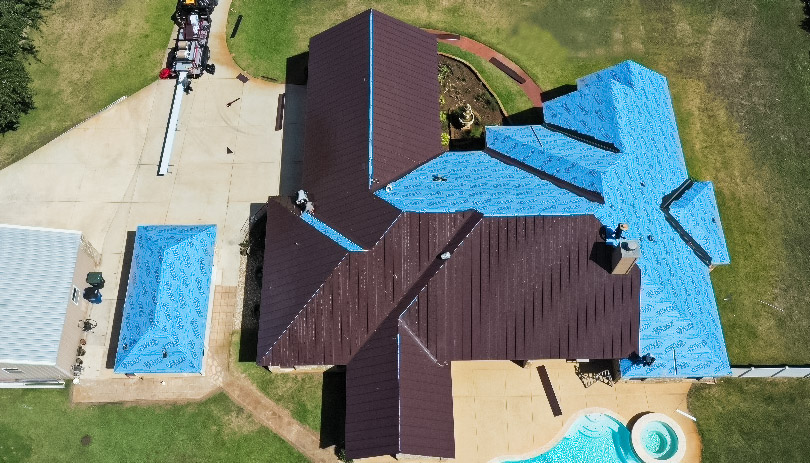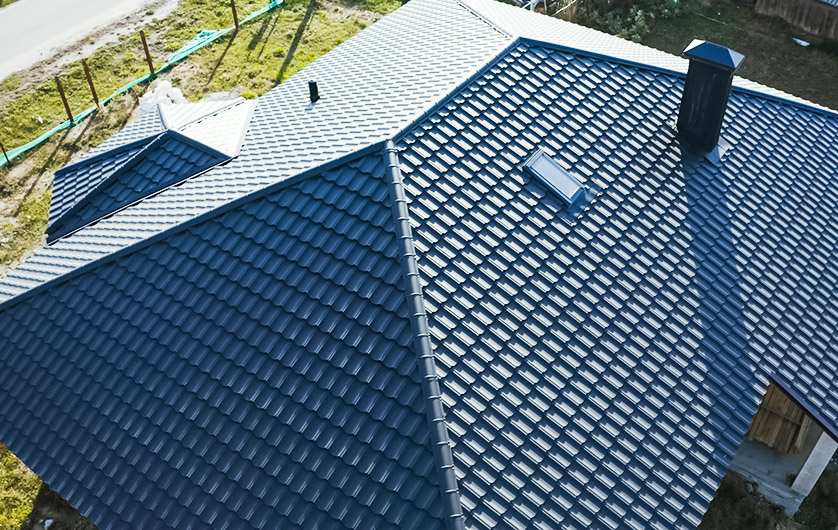Texas is a state known for its heat and arid environment. With temperatures often reaching well into the triple digits, it can be quite uncomfortable in Texas during the summer months. But what about roofs? How hot do they get when exposed to this intense sun? This article will explore how hot roofs can become in Texas and discuss some of the implications that come with roof temperatures in this region of the United States.
To understand how hot rooftops can become in Texas, one must first consider several factors such as geographical location, material composition, and design characteristics. Geographically speaking, certain parts of Texas are hotter than other areas due to their proximity to bodies of water or elevation differences. In addition to geography, materials used on the surface of a rooftop play an important role in determining temperature; dark-colored rooftops absorb more energy from sunlight resulting in higher temperatures compared to lighter-colored ones. Lastly, the way a rooftop is designed affects how much solar energy is absorbed by its surface area; having reflective surfaces helps reduce rooftop heating whereas sloped designs increase exposure to direct sunlight which leads to greater absorption and therefore higher temperatures.
The effects of high rooftop temperatures should also not be underestimated since these extreme conditions have been linked to structural damage over time as well as increased cooling costs associated with air conditioning systems attempting to combat high indoor temperatures caused by heat transfer from outside sources such as rooftops. Therefore, understanding how hot rooftops can become in Texas is essential for any homeowner looking to maximize comfort while minimizing costs related to repairs and energy consumption.
Solar Radiation Levels In Texas
Solar radiation levels in Texas vary significantly due to its size and geography. The highest solar radiation is seen in the western regions, where temperatures can reach well over 100 degrees Fahrenheit during summer months. Average daily values for peak sunshine hours range from 8-10 hours per day, depending on location. The amount of direct sunlight that reaches a roof depends on factors such as cloud cover, wind speed and direction, building height, nearby trees or buildings casting shade, and other atmospheric conditions. On average, rooftops exposed to direct sun will reach temperatures between 140-180°F during peak daylight hours. Roofs with lighter colors tend to absorb less heat than darker colored surfaces because they reflect more light away from the surface.
Average Roof Temperature In The State
Texas experiences high levels of solar radiation, which can cause roofs to become very hot over the course of a day. The temperature of a roof in Texas is affected by multiple environmental factors such as humidity, time of year, and ambient air temperature. In general, the higher the average daily temperature during the summer months, the hotter a roof will get. During peak hours on sunny days in July or August, it is not uncommon for rooftop temperatures to exceed 140 degrees Fahrenheit.
Asphalt shingles are one type of material commonly used on residential rooftops in Texas. Asphalt’s dark color absorbs more heat than lighter colors, meaning that asphalt roofs tend to reach even higher temperatures than other materials such as metal or ceramic tile. Additionally, when attic ventilation is lacking, an asphalt-covered roof may be significantly warmer due to inadequate cooling from cross breezes within the interior space. Without adequate ventilation and insulation systems in place, homeowners should expect their roofs to experience increased temperatures throughout the summer season.
Factors Affecting Roof Heat Gain
The amount of heat gain on a roof in Texas is largely dependent upon several factors. Firstly, the color of the roofing material plays an important role in this equation. Dark colors absorb more heat than lighter colored materials, causing roofs to become hotter in warmer climates such as Texas. Second, insulation also affects the amount of heat that can be retained by a roof due to its ability to slow down conduction and convection within the building envelope. Thirdly, air leakage around windows and doors contribute to temperature fluctuations and energy loss from a home or business. Lastly, ventilation systems help reduce temperatures in attics and other enclosed spaces on hot days by allowing air circulation throughout the space. All these elements combine to create varying levels of roof heat gain depending on their combination and usage.
Insulation And Ventilation Strategies To Regulate Heat
In Texas, the summer temperatures can be extremely high and cause a roof to become very hot during the day. To keep the heat in check, proper insulation and ventilation strategies are necessary. Insulation is one of the most important components for maintaining a comfortable interior temperature while also reducing energy costs due to cooling equipment running all day long. Installing reflective foil barriers on top of attic floor joists or between rafters helps reduce radiant heat transfer through roofs and walls, making them more resistant to extreme outdoor temperatures. Additionally, choosing an appropriate R-value insulation material is essential when selecting materials that provide enough thermal resistance to maintain desired indoor air temperatures.
Ventilation systems help balance out air pressure between inside and outside environments by providing continuous airflow through a building’s envelope. This process allows hot air from outside to escape and cool air from inside to enter, creating natural convection currents which ultimately regulate temperatures within living spaces and attics. Properly designed ventilation techniques should include adequate soffit vents as well as ridge vents at roof peaks for maximum efficiency. Additionally, it is beneficial to install gable end vents if possible since they allow heated attic air access directly from outdoors rather than having to pass through living areas first. With these steps taken into consideration, homeowners can rest assured that their home will remain cooler during those sweltering summer days in Texas.
Seasonal Variations In Temperature
In Texas, the temperatures can vary significantly between summer and winter. During summer months, when the sun is at its strongest, roofs can reach extreme temperatures as high as 150 degrees Fahrenheit or more in direct sunlight. This intense heat radiates into a home’s attic space, making it difficult to cool down during hot afternoons or evenings. In contrast, during winter months roof temperatures typically remain much cooler due to reduced amounts of solar radiation. However, if there are snow coverings on rooftops, they will act like an extra layer of insulation that helps keep homes warm even in frigid weather conditions. Overall, seasonal variations in temperature dictate how hot a roof gets in Texas – with summers seeing extremely high temps and winters yielding considerably lower readings.
Cool Roofs And Energy-Efficient Coatings For Protection
Cool roofs and energy-efficient coatings are designed to protect a roof from the heat of Texas. These systems serve as an extra layer, shielding the surface of the roof from direct sunlight. The benefits include reducing the amount of solar radiation absorbed by the building, cooling air temperatures inside and outside, and lowering heating and cooling costs. In addition, cool roofs can extend their life expectancy by preventing damage from high temperatures or UV exposure.
There are many options for selecting a cool roof system and coating material depending on one’s needs. Light colors reflect more light than dark ones; lighter paint is generally more reflective than darker paint; and white membranes such as TPO (thermoplastic polyolefin) or PVC (polyvinyl chloride) offer higher levels of reflection than other materials. Additionally, elastomeric coatings provide excellent protection against moisture infiltration while still allowing vapor permeability with minimal thermal resistance. When properly installed, they may last up to 20 years before needing repair or replacement.
When considering how hot a roof gets in Texas, it is important to take into account protective measures like cool roofs and energy-efficient coatings that can help shield surfaces from damaging UV rays and extreme temperatures. With proper installation techniques these systems can reduce temperature buildup significantly during warmer months so homeowners enjoy greater comfort indoors without sacrificing performance outdoors.

Danger Of Overheating On Unprotected Surfaces
The use of cool roofs and energy-efficient coatings to protect the roof from overheating is a great way to ensure that your roof does not become too hot. However, in areas where temperatures are high year round such as Texas, it is important to be aware of the dangers associated with unprotected surfaces. If left exposed for long periods of time, these surfaces can reach dangerously high temperatures which could cause serious damage or pose safety risks.
To minimize this risk, homeowners should inspect their roofs regularly for signs of heat stress. This includes checking for excessive cracking or blistering on the surface of the roof due to extreme heat exposure. If any issues are found, they should be addressed immediately by either hiring a professional contractor or installing an appropriate cooling system such as reflective paint or insulation board. Additionally, proper ventilation can help regulate temperature levels inside the home and reduce the amount of heat being transferred through the attic space into living spaces below. Taking these measures will help keep everyone safe and prevent costly repairs down the line.


